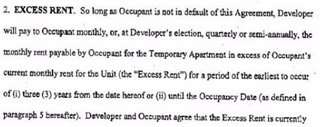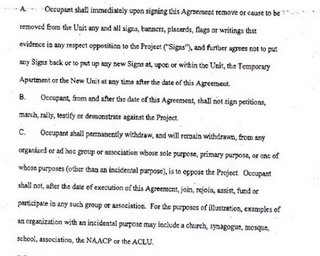At the Community Board 8 hearing on Atlantic Yards Thursday, Shabnam Merchant of Develop Don’t Destroy Brooklyn read a statement from South Brooklyn Legal Services (SBLS). It warned that rent-regulated tenants left in the proposed project footprint remain vulnerable, given the relocation agreements that Forest City Ratner (FCR) has offered.
FCR's Jim Stuckey later said no, that the tenants would not be left out in the cold, yet he was unwilling--at least for the time being--to provide documentary evidence of that.
What the agreements say
Yes, the agreements sound good. They'd pay the difference between their current rent and that charged for a new apartment, and they'd be guaranteed a space in the Atlantic Yards project at their previous rent.
 However, the relocation agreements, according to SBLS, “leave [renters] vulnerable.” The agreements would pay the differential in rent for only three years, which means that, given that the project wouldn’t be finished until 2010 at the earliest, the tenant would be left paying a high rent for some unspecified period.
However, the relocation agreements, according to SBLS, “leave [renters] vulnerable.” The agreements would pay the differential in rent for only three years, which means that, given that the project wouldn’t be finished until 2010 at the earliest, the tenant would be left paying a high rent for some unspecified period.
Indeed, as the excerpt above from one agreement offered last year shows, the differential would last three years.
Gag order and more
 Also, if Forest City Ratner walks away from the project for any reason, the deal is void. Finally, the agreement requires that the signers cease from any opposition to the project (right). By contrast, tenants in rent-regulated apartments are guaranteed many more protections if their building is to be demolished.
Also, if Forest City Ratner walks away from the project for any reason, the deal is void. Finally, the agreement requires that the signers cease from any opposition to the project (right). By contrast, tenants in rent-regulated apartments are guaranteed many more protections if their building is to be demolished.
Stuckey says it's ok
I caught up with Jim Stuckey, president of FCR's Atlantic Yards Development Group, after his statement to CB8, and asked him about the relocation agreements.
“The three years was never meant to be a period that we would leave people out in the lurch," he said. "And if it turns out for any reason at all that we have to contribute to subsidizing them for a longer period of time, that we will certainly do that. This was negotiated with people earlier on, and the project has actually taken on new life, but there’s no question in my mind that if it takes longer, we will take care of them.”
 The document I've excerpted was dated 2005, so "earlier on" is relative, though perhaps it was the same document offered a year earlier. Also, as the excerpt at right shows, another segment suggests that the contract would offer protection for five years, not three, which would be a greater degree of protection.
The document I've excerpted was dated 2005, so "earlier on" is relative, though perhaps it was the same document offered a year earlier. Also, as the excerpt at right shows, another segment suggests that the contract would offer protection for five years, not three, which would be a greater degree of protection.
Was that contradictory draftsmanship aimed to mislead, or just a careless discrepancy?
What's the policy?
So, has the developer agreed to subsidize differential rent for longer than three years for the renters who've already left the footprint? “I just won’t—even though it would be to my benefit to do so—violate confidentiality," Stuckey responded. "I just won’t do it.”
Well, FCR did agree to waive confidentiality agreements for an April New York Times article about condo owners and others who sold their property to the developer, and the article was favorable enough to make an Atlantic Yards e-newsletter.
If Forest City Ratner has agreed to subsidize differential rent for as long as necessary, that would be news, and redound to the developer's credit.
What should a tenant do?
I reminded Stuckey that current tenants are being advised by SBLS that the agreements leave them vulnerable.
“I think maybe their attorney’s saying that,” he responded.
So, I asked, what agreements are how being offered to people still left in the footprint?
He wouldn't specify how many years of differential rent would be paid. “I think the answer is: 'we’ll take care of them,'" he said. "What I’m not going to do is get into the specifics with individuals.”
It would be good, I said, to see it in writing.
“In time,” he responded.
FCR's Jim Stuckey later said no, that the tenants would not be left out in the cold, yet he was unwilling--at least for the time being--to provide documentary evidence of that.
What the agreements say
Yes, the agreements sound good. They'd pay the difference between their current rent and that charged for a new apartment, and they'd be guaranteed a space in the Atlantic Yards project at their previous rent.
 However, the relocation agreements, according to SBLS, “leave [renters] vulnerable.” The agreements would pay the differential in rent for only three years, which means that, given that the project wouldn’t be finished until 2010 at the earliest, the tenant would be left paying a high rent for some unspecified period.
However, the relocation agreements, according to SBLS, “leave [renters] vulnerable.” The agreements would pay the differential in rent for only three years, which means that, given that the project wouldn’t be finished until 2010 at the earliest, the tenant would be left paying a high rent for some unspecified period.Indeed, as the excerpt above from one agreement offered last year shows, the differential would last three years.
Gag order and more
 Also, if Forest City Ratner walks away from the project for any reason, the deal is void. Finally, the agreement requires that the signers cease from any opposition to the project (right). By contrast, tenants in rent-regulated apartments are guaranteed many more protections if their building is to be demolished.
Also, if Forest City Ratner walks away from the project for any reason, the deal is void. Finally, the agreement requires that the signers cease from any opposition to the project (right). By contrast, tenants in rent-regulated apartments are guaranteed many more protections if their building is to be demolished.Stuckey says it's ok
I caught up with Jim Stuckey, president of FCR's Atlantic Yards Development Group, after his statement to CB8, and asked him about the relocation agreements.
“The three years was never meant to be a period that we would leave people out in the lurch," he said. "And if it turns out for any reason at all that we have to contribute to subsidizing them for a longer period of time, that we will certainly do that. This was negotiated with people earlier on, and the project has actually taken on new life, but there’s no question in my mind that if it takes longer, we will take care of them.”
 The document I've excerpted was dated 2005, so "earlier on" is relative, though perhaps it was the same document offered a year earlier. Also, as the excerpt at right shows, another segment suggests that the contract would offer protection for five years, not three, which would be a greater degree of protection.
The document I've excerpted was dated 2005, so "earlier on" is relative, though perhaps it was the same document offered a year earlier. Also, as the excerpt at right shows, another segment suggests that the contract would offer protection for five years, not three, which would be a greater degree of protection. Was that contradictory draftsmanship aimed to mislead, or just a careless discrepancy?
What's the policy?
So, has the developer agreed to subsidize differential rent for longer than three years for the renters who've already left the footprint? “I just won’t—even though it would be to my benefit to do so—violate confidentiality," Stuckey responded. "I just won’t do it.”
Well, FCR did agree to waive confidentiality agreements for an April New York Times article about condo owners and others who sold their property to the developer, and the article was favorable enough to make an Atlantic Yards e-newsletter.
If Forest City Ratner has agreed to subsidize differential rent for as long as necessary, that would be news, and redound to the developer's credit.
What should a tenant do?
I reminded Stuckey that current tenants are being advised by SBLS that the agreements leave them vulnerable.
“I think maybe their attorney’s saying that,” he responded.
So, I asked, what agreements are how being offered to people still left in the footprint?
He wouldn't specify how many years of differential rent would be paid. “I think the answer is: 'we’ll take care of them,'" he said. "What I’m not going to do is get into the specifics with individuals.”
It would be good, I said, to see it in writing.
“In time,” he responded.
Comments
Post a Comment